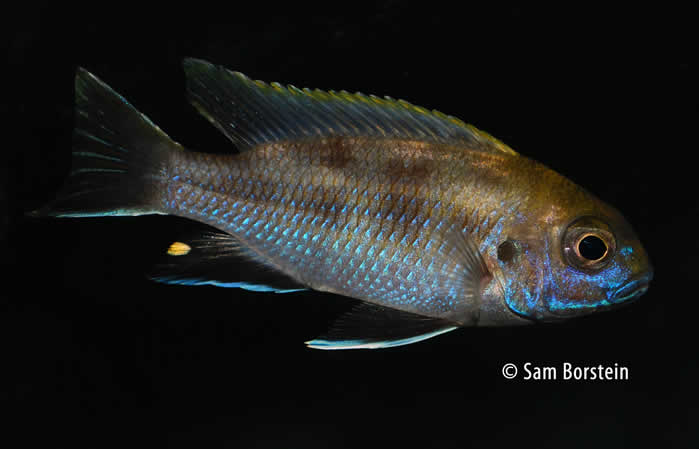Pseudotropheus livingstonii
(Boulenger, 1899)
Synonyms: Metriaclima livingstonii, Metriaclima lanistacola (misidentification), Pseudotropheus elegans (misidentification)

Above: A male Pseudotropheus livingstonii "Likoma". Photo by Sam Borstein.
Etymology:
Genus- Pseudotropheus= False Tropheus (Latin).
Species- livingstonii= Named after the explorer David Lingstone.
Intro:
Pseudotropheus livingstonii is a sand dwelling mbuna from Lake Malawi and was described by Boulenger in 1899. This species is one of two mbuna known to use snail shells as shelter. Both Pseudotropheus livingstonii and Metriaclima lanisticola use snails of the Lanistes genus as refuge. This fish has been subject to some confusion in past as it has been sold under many erroneous names.
For many years Metriaclima lanisticola was considered to be a synonym of Pseudotropheus livingstonii. It is in fact a valid species. It turns out that almost all fish in the hobby that were called Pseudotropheus livingstonii were in fact Metriaclima lanisticola, and the true Pseudotropheus livinstonii were labeled as Pseudotropheus elegans. Konings, in his 2007 book stated Metriaclima lanisticola was valid and described difference between it and Pseudotropheus livingstonii. Metriaclima lanisticola can be differentiated from Pseudotropheus livingstonii by its shorter, stockier appearance and striations in its fins. He also decided Pseudotropheus elegans was a synonym of Pseudotropheus livingstonii. Later, in a 2010 issue of Cichlid News, Konings states that Pseudotropheus elegans is in fact the common aquarium fish Pseudotropheus sp. "acei".
Pseudotropheus livingstonii is rather plain fish with a mostly brown/beige background color with some darker stripes. Males get somewhat of a purple or blue sheen on their sides. The fins of the fish are plain, but depending on location variant can range in a base color of clear-yellow. Although it lacks in the color department, it is a very active, mild, and interesting species.
Distribution:
Pseudotropheus livingstoniii is found throughout Lake Malawi over open sandy areas, occasionally around Lanistes snail shells, which some use as refuge.
Size, Maturity, and Sexual Dimorphism:
Size: Males- 6 inches, Females- 3.5 inches
Maturity: 1.5 inches
Sexual Dimorphism: Males are larger than females and far more colorful than females. Males get a blue-purple sheen and have more pronounced egg spots.
Care:
Pseudotropheus livingstonii is easy to care for and is a hardy fish. It is best to decorate the tank with a sand substrate and some hiding places such as rocks and shells. Yes, they will use shells, although as the fish grow, the shells do need to become larger. The fish are slightly aggressive, but a young group can be easily kept in a 40 breeder and an older group in a 75 gallon tank. The fish do like regular water changes. I did 50% weekly and the fish thrived.
Diet:
In the wild, Pseudotropheus livingstonii picks algae from the sandy substrate bottom. In aquaria, this fish is very easy to feed and not picky. A mix of pellet foods, flakes, and frozen foods will be accepted with no issues. It is recommended to add some fibrous foods to this fish’s diet. I fed New Life Spectrum, HBH Graze, and Dianichi Color fx and Veggie fx.
Breeding:
Pseudotropheus livingstonii poses no problems when it comes to spawning in an aquarium. The fish will breed when small; mine bred as small as 1.5 inches! The fish breed in a typical Pseudotropheus fashion. The females are good holders. Broods tend to be small, a large spawn would exceed 20 fry. These fish hold for a much shorter period than that of the typical mbuna, 13-15 days. The fry are tiny, but able to eat newly hatched brine shrimp. The most likely reason for the short incubation period and the small fry size is that these fishes release their fry into shells which offers protection.
Conclusion:
I really enjoyed keeping Pseudotropheus livingstonii. It was a very undemanding fish that mixed well with other Malawi cichlids. This is a very interesting species and fun to watch, especially when they use shells. I personally believe that this would be a much more popular fish if it wasn't so drab. This is an active species that is not overly aggressive and would be good even for a beginner.
References:
- Boulenger, G.A. (1899) A revision of the African and Syrian fishes of the family Cichlidae. Part II; Proceedings of the Zoological Society of London, 98-143.
- Konings, A. (2001) Malawi cichlids in their natural habitat. 3rd ed., Cichlid Press, El Paso, Texas, 352 pp.
- Konings, A. (2007) Malawi cichlids in their natural habitat. 4th ed., Cichlid Press, El Paso, Texas, 424 pp.
